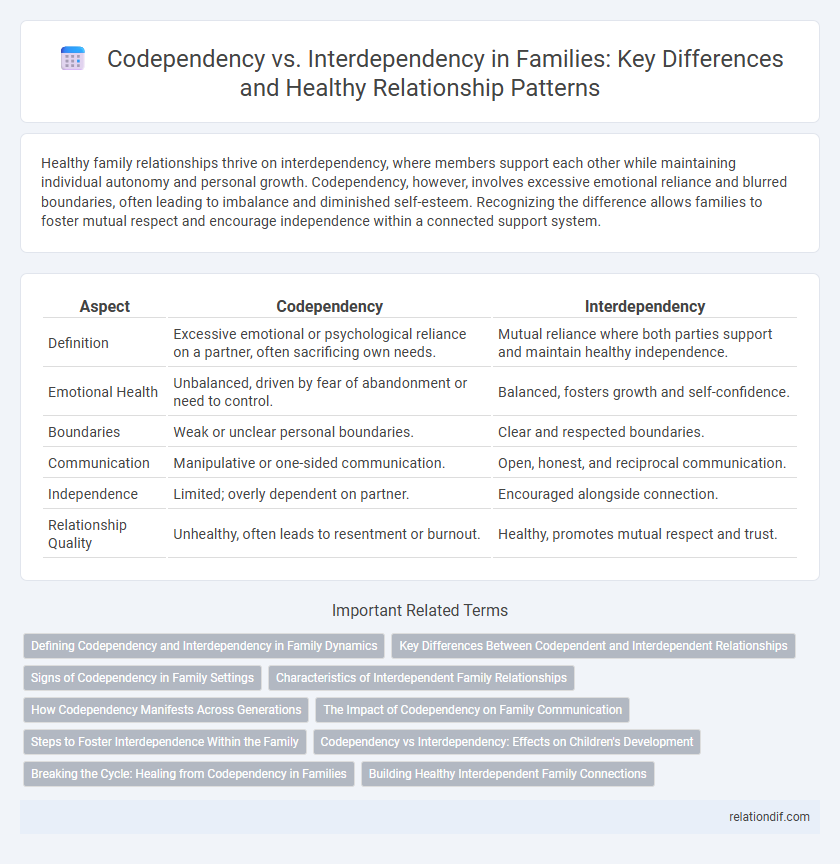Healthy family relationships thrive on interdependency, where members support each other while maintaining individual autonomy and personal growth. Codependency, however, involves excessive emotional reliance and blurred boundaries, often leading to imbalance and diminished self-esteem. Recognizing the difference allows families to foster mutual respect and encourage independence within a connected support system.
Table of Comparison
| Aspect | Codependency | Interdependency |
|---|---|---|
| Definition | Excessive emotional or psychological reliance on a partner, often sacrificing own needs. | Mutual reliance where both parties support and maintain healthy independence. |
| Emotional Health | Unbalanced, driven by fear of abandonment or need to control. | Balanced, fosters growth and self-confidence. |
| Boundaries | Weak or unclear personal boundaries. | Clear and respected boundaries. |
| Communication | Manipulative or one-sided communication. | Open, honest, and reciprocal communication. |
| Independence | Limited; overly dependent on partner. | Encouraged alongside connection. |
| Relationship Quality | Unhealthy, often leads to resentment or burnout. | Healthy, promotes mutual respect and trust. |
Defining Codependency and Interdependency in Family Dynamics
Codependency in family dynamics is characterized by excessive emotional or psychological reliance on another member, often leading to enabling behaviors and loss of individual autonomy. Interdependency, however, reflects mutual support and healthy boundaries where family members balance independence with cooperation and shared responsibilities. Understanding these distinctions helps promote healthier relationships by fostering self-sufficiency alongside emotional connection.
Key Differences Between Codependent and Interdependent Relationships
Codependent relationships are characterized by excessive emotional reliance on one partner, often leading to a loss of individual identity and unhealthy boundaries. Interdependent relationships, however, involve mutual support and respect, where both partners maintain autonomy while fostering a balanced connection. Key differences include the presence of unhealthy dependence in codependency versus healthy, reciprocal cooperation in interdependency.
Signs of Codependency in Family Settings
Signs of codependency in family settings include an excessive need for approval, difficulty setting personal boundaries, and a pattern of enabling unhealthy behaviors in loved ones. Family members may sacrifice their own needs to care for others, leading to imbalance and emotional exhaustion. Codependent dynamics often feature controlling behaviors masked as caretaking, preventing individual growth within the family unit.
Characteristics of Interdependent Family Relationships
Interdependent family relationships are characterized by mutual respect, open communication, and shared responsibilities that foster emotional support and individual growth. Members maintain healthy boundaries while relying on each other for guidance, encouragement, and collaboration, promoting resilience. Trust and accountability serve as foundational elements, enabling each person to express their needs and contribute actively to the family's well-being.
How Codependency Manifests Across Generations
Codependency manifests across generations through patterns of excessive reliance on others for emotional support and identity, often rooted in unresolved family trauma or dysfunction. These behaviors include enabling harmful habits, suppressing personal needs, and difficulty setting boundaries, which perpetuate cycles of emotional imbalance within family systems. Intergenerational transmission of codependency can hinder individual autonomy and healthy relationship dynamics, contrasting with interdependency where mutual support fosters personal growth and resilience.
The Impact of Codependency on Family Communication
Codependency in family relationships often hinders open and honest communication, creating an environment where members rely excessively on each other for approval and emotional support. This dynamic fosters misunderstandings, suppresses individual needs, and perpetuates unhealthy communication patterns that reinforce dysfunction. In contrast, interdependency promotes balanced emotional exchanges and mutual respect, enabling healthier and more effective family communication.
Steps to Foster Interdependence Within the Family
Encouraging open communication and setting healthy boundaries are crucial steps to foster interdependence within the family, promoting mutual respect and support. Developing individual strengths while collaborating on shared goals enhances emotional resilience and collective problem-solving. Regular family meetings and rituals reinforce trust and accountability, creating a balanced environment where members thrive both independently and together.
Codependency vs Interdependency: Effects on Children's Development
Codependency in families often leads to children developing low self-esteem and difficulty setting boundaries due to over-responsibility and enmeshment with caregivers. In contrast, interdependency fosters healthy emotional regulation and autonomy by encouraging mutual support and respect for individuality. These distinct dynamics significantly shape children's social skills, emotional resilience, and future relationship patterns.
Breaking the Cycle: Healing from Codependency in Families
Breaking the cycle of codependency in families requires recognizing unhealthy patterns where one member overly relies on another for emotional support or validation, often neglecting personal boundaries. Healing involves fostering interdependency, which promotes mutual respect, balanced support, and individual autonomy within relationships. Therapeutic interventions like family counseling and self-help strategies empower members to develop healthier communication skills and rebuild trust, ultimately strengthening family resilience.
Building Healthy Interdependent Family Connections
Building healthy interdependent family connections requires balancing mutual support with individual autonomy, ensuring each member contributes to and benefits from shared responsibilities. Unlike codependency, where boundaries blur and reliance becomes unhealthy, interdependency fosters respect, communication, and emotional resilience. Prioritizing open dialogue and trust strengthens family bonds, promoting growth and well-being for all members.
codependency vs interdependency Infographic

 relationdif.com
relationdif.com